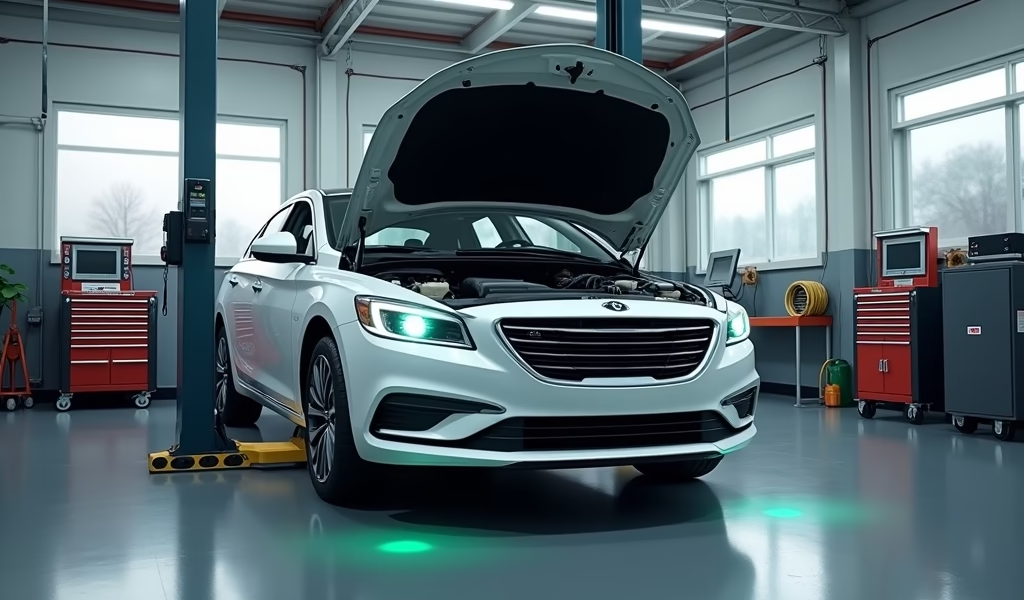Overview
This article provides a detailed guide on diagnosing and repairing car AC refrigerant leaks, covering causes, detection methods, DIY repair techniques, and preventive maintenance strategies. It explains when to attempt repairs yourself versus seeking professional help, emphasizing that while simple issues like O-ring replacements can be handled by DIYers, complex problems involving evaporator leaks or electronic controls often require specialized equipment and expertise.
Table of Contents
- Understanding Car AC Leaks: Causes and Signs
- Diagnosing an AC Leak: Where to Look
- Tools and Materials You’ll Need
- DIY Methods to Fix Car AC Leaks
- Preventing Future Air Conditioner Leaks
- When to Call a Professional
- Conclusion
- Frequently Asked Questions
Understanding Car AC Leaks: Causes and Signs
When your car’s air conditioner stops blowing cold air on a sweltering summer day, few things are more frustrating. Often, the culprit behind this automotive discomfort is an AC leak. Having spent over two decades fixing these issues, I can tell you that understanding what you’re dealing with is half the battle when tackling how to fix a car air conditioner leak.
Car AC systems are sealed units designed to circulate refrigerant (commonly R-134a or the newer R-1234yf in recent models) under varying pressure conditions. When this sealed system develops a breach, the refrigerant escapes, and your once-refreshing cabin turns into a rolling sauna.
Several common causes typically lead to AC leaks in vehicles:
- Natural wear and tear on rubber seals, O-rings, and hoses
- Corrosion on metal components like the condenser or evaporator
- Vibration damage loosening connections over time
- Road debris striking and damaging exposed components
- Manufacturing defects (less common but still possible)
Before diving into repairs, you’ll want to confirm you’re dealing with a leak. The telltale signs include:
- Gradually decreasing cooling performance (your AC becomes less effective over days or weeks)
- The AC blows cold initially but warms up after a short period
- Visible oily residue around AC components (refrigerant carries oil that can leave traces)
- Hissing sounds near AC components when the system is running
- The AC clutch cycling on and off frequently or not engaging at all
One thing many folks don’t realize is that small AC leaks can be particularly tricky. Your system might still work somewhat while slowly losing refrigerant, making the problem easy to ignore until you’re completely out of cooling power. That’s why catching and addressing leaks early can save you significant headaches (and dollars) down the road.
Diagnosing an AC Leak: Where to Look
Finding the exact location of an air conditioner leak requires some detective work. In my years at the shop, I’ve found that patience during diagnosis saves hours of frustration later. The most common leak points include connections between hoses and components, the condenser (located at the front of your car near the radiator), the compressor seals, and the evaporator (hidden inside your dashboard).
To properly diagnose your car’s AC leak, you’ll need to methodically inspect the entire system. Start with a visual examination—look for oily residue around connections and components. This oil is mixed with the refrigerant and leaves a telltale trace wherever leaks occur.
For a more definitive diagnosis, you have several options:
- UV dye detection: The most reliable DIY method involves adding UV dye to the system, running the AC, then using a special UV light to spot the glowing dye at leak points
- Soap solution test: Mix dish soap with water, apply it to suspected leak areas, and look for bubbles forming when the AC runs
- Electronic leak detectors: These handheld devices “sniff out” refrigerant and alert you when it’s detected
Pay particular attention to connection points—these are prime locations for leaks to develop. The Schrader valve (similar to your tire valve) on the low-pressure line is another common culprit that’s often overlooked. Sometimes it’s just a loose valve that needs tightening.
When checking the condenser at the car’s front, look carefully for tiny pinhole leaks caused by road debris. These can be easy to miss but are a frequent source of refrigerant loss. Similarly, the compressor seal may develop leaks after years of use, typically showing oil residue around the compressor shaft.
Remember, an AC system can lose up to 15% of its refrigerant naturally over a year, but anything more than that indicates a leak that needs addressing. Being thorough in your diagnosis now will make your repair efforts much more effective.

Tools and Materials You’ll Need
Before diving into your AC repair project, gathering the right tools and materials will make the job go smoother. Trust me—I’ve seen plenty of Saturday afternoon repairs turn into weekend-long ordeals because someone wasn’t properly prepared. Here’s what you’ll need to fix a car air conditioner leak effectively:
Essential Tools:
- Safety glasses and gloves (refrigerant can cause frostbite on contact)
- AC manifold gauge set (to check system pressure)
- UV leak detection kit (includes dye, UV light, and glasses)
- Socket set and wrenches (various sizes for your specific vehicle)
- Screwdrivers (flathead and Phillips)
- Vacuum pump (for system evacuation)
- Recovery machine (if you’re recovering old refrigerant—often better left to professionals due to environmental regulations)
Materials Needed:
- Refrigerant appropriate for your vehicle (R-134a or R-1234yf)
- AC stop leak sealant (for minor leaks only)
- O-rings and seals kit (match to your vehicle’s make and model)
- AC system oil (specific type for your compressor)
- Replacement parts as needed (hoses, condenser, etc.)
- Thread sealant or Teflon tape (for threaded connections)
A word about refrigerant handling: Working with refrigerant requires care not just for your safety, but for environmental reasons too. Modern refrigerants can contribute to atmospheric damage if released carelessly. Many areas have regulations about handling refrigerant, with some requiring certification for purchase. Always check local regulations before attempting repairs involving refrigerant handling.
For those just starting out, EPA guidelines on refrigerant handling provide valuable information about the safe and legal handling of AC refrigerants. The investment in proper tools might seem steep initially, but when you compare it to professional repair costs for multiple AC issues, they quickly pay for themselves.
If you’re working on an older vehicle with a simpler AC system, you might get by with fewer specialized tools. However, modern vehicle AC systems are increasingly complex and may require more specific equipment. When in doubt, consult your vehicle’s service manual—it’s an investment that can save you countless hours of trial and error.
DIY Methods to Fix Car AC Leaks
Now for the hands-on part! After years of fixing AC systems, I’ve found that most leaks fall into a few common categories, each with its own repair approach. Let’s walk through the most effective DIY methods to fix a car air conditioner leak, starting with the simplest fixes and progressing to more involved repairs.
Method 1: Using AC Stop Leak Products
For minor leaks, especially those too small to locate easily, AC stop leak products can be a good first attempt. These sealants circulate with the refrigerant and plug tiny holes from the inside.
- Ensure your system has some refrigerant remaining (the sealant needs to circulate)
- Connect the stop leak product according to package directions (typically to the low-pressure port)
- Add the recommended amount and run the AC for 15-20 minutes to circulate
- Top off the refrigerant if needed following the product instructions
Remember, these products are best suited for very small leaks and might not provide permanent fixes for larger issues. Think of them as a band-aid rather than surgery.
Method 2: Replacing O-rings and Seals
Leaky connections are often caused by deteriorated O-rings and seals, which is good news because they’re relatively easy to replace:
- Recover any remaining refrigerant (or have a professional do this step)
- Disconnect the leaking connection, being careful not to damage threaded parts
- Remove the old O-ring or seal and clean the connection thoroughly
- Apply a small amount of AC system oil to the new O-ring
- Install the new seal and reconnect, ensuring proper alignment
- Vacuum the system to remove air and moisture, then recharge with refrigerant
Method 3: Fixing Leaky Hoses
Hoses can develop cracks or leaks at crimped connections. If you’ve found a leaking hose:
- Recover the refrigerant from the system
- Remove the faulty hose completely
- Replace with a new OEM or quality aftermarket hose (avoid splicing as this creates potential future leak points)
- Always replace the O-rings at both ends of the new hose
- Vacuum and recharge the system
Method 4: Addressing Component Leaks
For leaks in major components like the condenser, evaporator, or compressor:
- Recover the refrigerant
- Remove the leaking component, which may involve removing other parts for access
- Install the replacement component with new O-rings at all connection points
- Add the appropriate amount of AC oil to the new component
- Reassemble, vacuum the system, and recharge with the correct amount of refrigerant
After any repair, it’s crucial to properly evacuate the system using a vacuum pump before recharging. This removes moisture and air that can reduce efficiency and cause damage. A proper vacuum should be held for at least 30 minutes to ensure the system is leak-free and completely dry.
When recharging, always follow the manufacturer’s specifications for refrigerant type and quantity. Overcharging can be just as problematic as undercharging, leading to poor performance and potential system damage. Your cooling system’s overall health depends on proper refrigerant levels, just as your radiator needs proper coolant levels.
Preventing Future Air Conditioner Leaks
An ounce of prevention is worth a pound of cure—especially when it comes to AC systems. Throughout my career, I’ve noticed that vehicles with well-maintained AC systems typically experience fewer leaks and enjoy longer component lifespans. Here are my top strategies to prevent future air conditioner leaks in your vehicle:
Regular Maintenance Practices
- Run your AC system year-round (even briefly in winter) to keep seals lubricated
- Have your system inspected annually by a qualified technician
- Replace the receiver/drier or accumulator every 3-4 years (these components contain desiccants that absorb moisture and eventually become saturated)
- Keep your condenser clean and free of debris by rinsing it occasionally (with the engine off)
- Address minor leaks promptly before they worsen
Driving Habits That Protect Your AC
Believe it or not, how you use your AC can impact its longevity. Consider adopting these habits:
- Allow your AC to run for a few minutes before turning it to maximum cooling (gives the compressor time to properly circulate oil)
- Turn off the AC a few minutes before reaching your destination while keeping the fan running (helps dry the evaporator and prevents mold)
- Avoid running the AC at maximum settings all the time (reduces strain on components)
- When possible, park in shaded areas to reduce the initial cooling load
System Upgrades Worth Considering
If you’ve experienced repeated leaks or are repairing an older system, consider these upgrades:
- Install a higher-quality condenser if your original is prone to leaking (some aftermarket options offer improved designs)
- Use barrier hoses when replacing AC lines (they’re more resistant to refrigerant permeation)
- Consider upgrading to modern, more durable O-rings and seals during repairs
- If compatible with your system, newer compressors often have improved seal designs
One often overlooked aspect of AC maintenance is the cabin air filter. While it doesn’t directly prevent refrigerant leaks, a clean filter improves airflow through the evaporator, reducing the work your AC system must perform. This decreased strain can extend component life. According to Department of Energy research, proper maintenance can improve efficiency by up to 15% and extend system life significantly.
Remember, your car’s AC system is designed to last the vehicle’s lifetime with proper care. Most leaks don’t “just happen”—they result from gradual wear, environmental factors, or lack of maintenance. A proactive approach can save you from sweaty summer drives and expensive emergency repairs.

When to Call a Professional
While I’m all for DIY repairs, there are times when even experienced mechanics know to call in reinforcements. Recognizing when a car AC issue exceeds your skills or equipment is a sign of wisdom, not weakness. Here are situations where professional help is your best bet when dealing with how to fix a car air conditioner leak:
Complex System Issues
- Evaporator leaks (buried deep in the dashboard, requiring extensive disassembly)
- Internal compressor failures that have distributed metal particles throughout the system
- Electronic control problems affecting the AC operation
- Multiple or recurring leaks that suggest systemic problems
Modern vehicles increasingly integrate their climate control with other vehicle systems. What seems like a simple AC leak might actually involve computerized controls, sensors, or actuators that require specialized diagnostic equipment. According to Motor Magazine’s research, up to 30% of AC issues in newer vehicles involve electronic components rather than refrigerant leaks.
Equipment Limitations
Some repairs simply require specialized equipment that isn’t cost-effective for occasional DIYers:
- Proper refrigerant recovery (required by law in most places)
- Vacuum pumps capable of pulling and holding proper system vacuum
- Accurate refrigerant charging equipment
- Electronic leak detection tools for finding microscopic leaks
The investment in this equipment can run into thousands of dollars—money better spent on professional service if you’re only addressing occasional AC issues.
Environmental and Safety Concerns
Refrigerant handling comes with legal and safety implications:
- Refrigerant must be properly recovered, not vented to atmosphere (EPA regulations carry stiff penalties for violations)
- Improper handling can result in frostbite or chemical burns
- Some newer vehicles use mildly flammable R-1234yf refrigerant, requiring additional safety precautions
Cost-Benefit Analysis
Sometimes, the professional route is actually more economical:
- Many shops offer AC leak detection for a reasonable fee
- Professionals can often access parts at better prices than retail
- A proper professional repair typically includes warranty coverage
- Failed DIY attempts can sometimes create additional problems, increasing total repair costs
When selecting a professional, look for ASE certification in HVAC or, better yet, Section 609 EPA certification specifically for automotive refrigerant handling. Ask if they use proper recovery equipment and what diagnostic methods they employ—shops using dye detection and electronic leak detectors tend to be more thorough.
Remember, a good mechanic won’t just fix your immediate leak but will inspect the entire system for potential issues, saving you from future problems. Sometimes, paying for expertise is the most cost-effective solution in the long run.
Conclusion
Tackling a car air conditioner leak might seem intimidating at first, but with the right approach, many leaks can be successfully repaired even by DIY enthusiasts. Throughout this guide, we’ve covered how to identify leaks, the tools needed, various repair methods, prevention strategies, and when to call in the professionals.
Remember that successful AC repair is about methodical troubleshooting and careful work. Take your time during diagnosis—finding the exact leak location is crucial to effective repair. Small leaks might be manageable with sealant products, while component failures will require part replacement. Either way, proper system evacuation and recharging are essential steps that can’t be skipped.
Preventative maintenance remains your best defense against future AC problems. Regular system operation, annual inspections, and prompt attention to minor issues can extend your AC system’s life considerably. Simple habits like keeping your condenser clean and running your AC periodically during cooler months pay dividends when summer heat arrives.
Whether you decide to tackle the repair yourself or seek professional help, understanding how your AC system works and what causes leaks empowers you to make informed decisions. Not every AC issue requires an expensive visit to the dealership, but some complex repairs are best left to trained technicians with specialized equipment.
The next time you’re faced with warm air blowing from your vents on a hot day, you’ll have the knowledge to approach the problem systematically. Stay cool, be patient with the process, and remember that most AC issues have logical solutions within reach.
Frequently Asked Questions
How much does it cost to fix a car AC leak professionally?
Professional AC leak repair typically costs between $150-$800 depending on the leak location and necessary parts. Simple O-ring replacements are on the lower end, while evaporator or compressor repairs are more expensive.
Can I drive with a car AC leak?
Yes, you can drive with an AC leak as it doesn’t affect engine performance or safety. However, continuing to run a leaking AC system may damage the compressor due to inadequate lubrication.
How long does AC stop leak take to work?
Most AC stop leak products begin working within 15-30 minutes of circulation through the system. Full sealing may take several driving cycles as the product needs to reach all potential leak points.
Will adding refrigerant fix an AC leak?
Simply adding refrigerant is a temporary solution that doesn’t address the underlying leak. The system will eventually lose the newly added refrigerant through the same leak point.
How do I know if my car AC compressor is leaking?
Compressor leaks typically show as oil residue around the shaft seal or housing joints. You might also notice a clutch that cycles rapidly or fails to engage due to low refrigerant pressure.


Pingback: Car Air Conditioning Maintenance Secrets - knowsyourcar.com